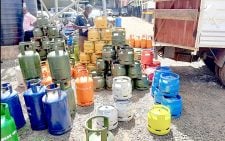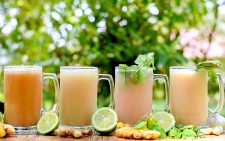Farm tourism blooms in arid Turkana landscape

Harriet James @harriet86jim
In the remote area of Katilu, about 120 kilometers from Lodwar, Turkana county, Steven Ekai welcomes us to his expansive farm.
On one end of the land are rows of maize crops planted together with paw paw trees, which gave us shade from the scorching heat.
For six hours, we had traversed the rough terrain leading to the farm, a journey that was made bearable by the reliable 4×4 car we drove in.
Katilu has been known for a while for its oil reserves, but has now been branded a new name, Israel, because of the emergence up of many farms that are slowly making the once drought stricken region food secure.
Known as a region of soils of high agricultural potential, aridity hinders its exploitation. The region is characterised by scarce, erratic rainfall patterns.
Green with vegetation
However, through irrigation, Steven and other farmers in the area have been able to change the landscape of a region once deemed unproductive.
One drip at a time the once bare fields are now green with vegetation spelling renewed hope for families that would otherwise be facing starvation and malnutrition.
Not only that, the area now also presents a great learning experience for those who visit.
Local visitors, as well as foreigners are awed by the once bare and dry land that has now been tranformed into a flourishing agricultural hub.
Apart from maize and paw paws, you will also come across sorghum, kales, sweet potatoes, mangos, oranges and all kinds of greeneries never thought of before.
The Ministry of Tourism through Kenya Tourism Board (KTB) is currently implementing a strategy to identify and promote a variety of signature experiences in the country, including Turkana.
Launched last year, the programme is in its second phase and promoting agritourism is part of the plan.
“There is no better way of building synergy between tourism and agriculture than embracing agritourism.
This will not only sustain our economic livelihoods, but also our tourism strategy to diversify product offerings,” said tourism Cabinet Administrative Secretary (CAS) Joseph Boinnet during the launch.
Agritourism is a dimension of tourism that combines both agriculture and tourism experience to not only tourists who are travelling for fun, but also professional meetings and lectures with experts in the different areas of agriculture.
Mostly linked to rural tourism, in recent times, it has experienced immense growth as a result of the surging demand of tourists who hunger for personalised services in unspoiled destinations, such as Turkana.
Not explored
While national and Turkana county tourism players agree that there is an enormous economic potential in this tourism segment and that many people are fascinated by holidaying in extreme environments, farm tourism, just like many other attractions in the region remains on a small scale, with much occurring in cities and their surroundings.
We toured another farm, a mango farm run by a Nangorot Women’s Group and I was gob smacked to see how green this side of the world was contradicting the common images of malnourished people, which has long defined the region.
The 49-acre farm was bought in 2012 by a group of men and women who desired to be self-sufficient and protect their children from malnutrition.
“We noticed that there was demand for mangoes and we opted to plant it,” says Peninah Akai, one of the group members, addding, “We never thought that mangoes would grow in this region, but we are happy to even have diversified to bananas and oranges, which we supply to the market and also to our guests who come to learn how we have managed to do this.”
In another farm, we learnt about a new method of farming known as hydroponic farming at the Turkana Basin Institute (TBI).
This kind of farming entails crops using mineral nutrient solutions in water, which in turn minimises the need for soil.
While plants don’t need soil to grow, they require nutrients and water to grow, which they easily get from the soil.
However, when there is no soil, they can get the nutrients elsewhere, by standing with their roots in a nutrient-rich solution.
Such kind is profitable for leafy greens, such as lettuce, spinach or kales as they have the lowest operational cost.
“This method is suitable in Turkana because of the drought and the soil too is not suitable for farming.
Being that the region too has shortage of water, this kind employs less water as that which is used is recycled and circulates back to the reservoir and into the farm,” explains Michael Kitumba of TBI.
On one side was the hydroponic greenhouse where lots of spinach securely grown to safeguard it from contamination.
On the other end were pawpaw trees and a dam which supplied water to the farm.
There is also a reservoir in another side that holds around 1,000 liters of water and has a power system that pumps water both in and out of the farm.
With a significant percentage of the growing urban population having little or no contact with agriculture, such trips are significant in ensuring that the demographic is aware of the methods, technologies, as well as crop cultivation in farms.
By touring farms, they also support the farm products through purchases made directly or indirectly in the farms.
One too gets an opportunity to reconnect with their soil by offering a ‘hands-on experience’ with the agricultural techniques and methods.












